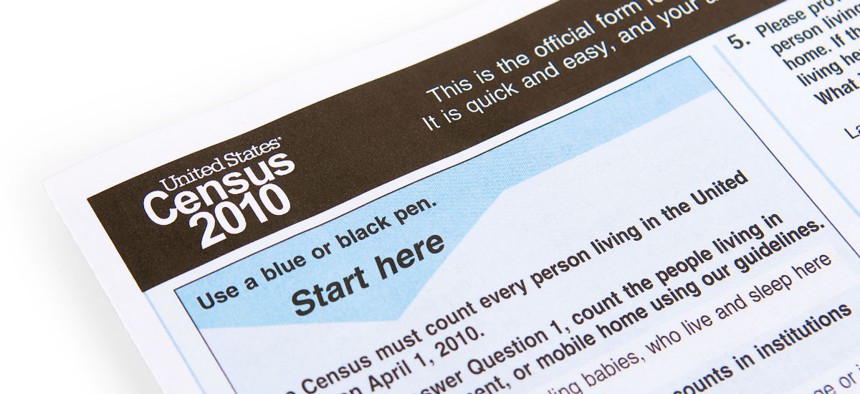Budget and Leadership Problems Plague 2020 Census, Raising Concern on Capitol Hill
Lawmakers worry about what one watchdog describes as a potentially "historically disastrous" outcome.
It is getting into crunch time for the Census Bureau as it prepares for the 2020 decennial headcount, and members of Congress and outside groups alike are expressing deep concern about the agency’s preparation.
Key oversight lawmakers in both the House and Senate have sent letters in recent days seeking assurances that the census will go off without a hitch. They pointed to potential problems arising from the recent resignation of the bureau’s director, cost overruns and redesign implementation. John Thompson, the bureau’s former director, announced his resignation—which became effective last week—in May, following a hearing in which he pressed lawmakers for adequate funding and explained the rising cost estimates for a new electronic system.
In a letter addressed to President Trump, the chairmen and ranking members of the Senate Homeland Security and Governmental Affairs and Commerce, Science and Transportation committees sounded the alarm about the lack of political leadership at the bureau as it moves “into the final three critical years.” In addition to the now vacant directorship, the deputy director and top political positions at the Commerce Department with Census oversight are also currently unfilled. Census is facing “serious challenges,” the lawmakers said, and Thompson’s departure has added yet another.
“The director’s resignation, six months prior to the end of his term, adds to the mounting challenges facing the Census Bureau and could further jeopardize the 2020 program moving forward,” the senators wrote. They encouraged the president to take “swift action” on the vacancies and to “make fully staffing the Census Bureau a priority.”
Census is entering a crucial phase as it prepares for 2020; next year, the bureau is planning to carry out its end-to-end test to “provide insights and guide our planning to ensure an accurate census,” according to the bureau. It will test “all major components” of the main event, including key technologies, data collection methods, outreach and promotional strategies and management processes. Census planned to use a 700,000 housing unit sample at various locations in Washington, Rhode Island and West Virginia, enabling it to test new strategies in urban, suburban and rural populations. Phil Sparks, co-director for the watchdog group The Census Project, however, said administration officials confirmed in a meeting he attended Thursday that the bureau was scrapping the testing in Washington and West Virginia due to funding shortfalls. That announcement raised particular concern, Sparks said, because Census has historically undercounted those in rural areas.
In February, the Government Accountability Office listed the 2020 Census on its annual High Risk List. GAO noted the rising costs—from $16 dollars per household in 1970 to $92 in 2010—and diminishing return rates, down to just 63 percent in the latest iteration. The auditors have made 30 recommendations to “help the bureau design and implement a more cost-effective census for 2020,” but the agency had implemented just six of them.
“They’re in a very tight situation, which frankly could—and I say could—lead to a historically disastrous Census,” Sparks said. While the Trump administration has requested a $27 million funding increase over the bureau's fiscal 2017 level, Sparks said much more is needed. As a point of comparison, the bureau's budget increased $300 million from 2007 to 2008 in preparation for the 2010 census. House lawmakers added $10 million to the administration's request during a recent markup, which would boost the year-over-year funding increase to $37 million.
Leaders on the House Oversight and Government Reform Committee pressed Census in a letter of their own on issues related to cost estimates and overruns. Just prior to announcing his resignation, Thompson informed Congress that Census’ key new data collection and processing tool had exceeded cost expectations by more than $300 million. A GAO official at that hearing said the cost could actually surpass estimates by $1 billion.
For the first time, the decennial census will instruct American residents on its first pass to answer its questions online. The bureau estimates it will then have to go door-to-door for about 40 percent of citizens. Had the agency stuck to its normal pencil-and-pad format, it estimated its costs would have increased by $5 billion compared to 2010.
The lawmakers requested an updated cost estimate for the 2020 Census, the changes since its last estimate in 2015, details on its cost estimation strategy and the succession plan in light of Thompson’s resignation. Commerce Secretary Wilbur Ross announced last week that Rio Jarmin, the current association director for Economic Programs at Census, will carry out the “non-exclusive functions and duties” of the director. He has worked at the agency for 25 years.
If there are any hiccups in the census implementation, Sparks said the Trump administration—which he said will have had years to fund and plan the project properly—“will own it.”
“This will become very evident to everybody in America because you can’t disguise a census failure when you’re involving 130 million households,” Sparks said. Noting it will be occurring during a presidential election year, he added, “There will be political ramifications.”
The Commerce Department did not respond to a request for comment.








